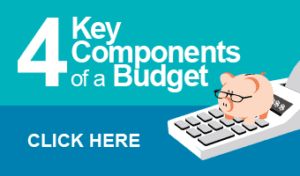Like physical and mental health, financial health is a cornerstone of quality of life. Our lives can feel very stressful when we are struggling financially. That’s why, while we don’t necessarily need to be rich, we do need to have a solid financial plan. As important as it is, it can be overwhelming to pull together a solid financial plan because they involve a lot of pieces. Trying to take it all on at once can just exacerbate things. Research has shown that small, consistent progress moves you forward much quicker than attempting big leaps. That’s why we created this 30-day Financial Plan Checklist! It breaks all the components of a solid financial plan and financial maintenance into easy-to-do tasks. At the end of 30 days, you’ll feel confident that your finances are on track to support you and the life you want.
Day 1: Financial goals
Any good financial plan starts with goals. Take some time to think about what you would like your money to do for you. Do you want to pay off debt, save for a house or a trip? The goal you chose will inform how you execute the rest of the tasks over the month, so write it (or them) down. Keep them nearby whenever you’re working on the task for the day to remind you of the end goal.
Day 2: Calculate income
We’ll ease into this 30 process with a simple step: calculate your income. To simplify the rest of the steps, you may find it better to calculate your net monthly income. This is how much you earn each month after taxes and other deductions have been taken off. In other words, how much actually goes into your bank account each month.
For those with one full-time job, this is pretty simple. For those with multiple jobs or a varied income each month, it may be a little more complicated. In those cases, calculate your average income for the last few months. Avoid over- (or under) estimating your income by weeding out any months where there was a huge spike or drop in income from a bonus or something else.
Day 3: List out expenses
Yesterday was all about what’s coming in; today’s all about what’s going out. List out all your expenses along with their due dates. It’s helpful to split them up into one of two categories: fixed or variable.
Fixed expenses are those that cost the same amount each month, whereas variable expenses fluctuate. Similar to what we did with income, calculate how much you spent in each variable expense, on average, for the last few months.
This is also a great time to go back to your goal(s) from Day 1. Take some time to assess which expenses help and which ones hold you back from getting where you want to go.
Day 4: Debt evaluation
Debt management plays a key role in overall financial health, so it’s a good idea to review your debts regularly. To do that, gather up statements from each of your creditors. These might be for:
You’ll want to do a few things. First, write down the credit limits, payment amounts and interest rates for each bill. Then use that information, along with your income, to calculate your debt-to-income ratio and credit utilization ratio. As a rule of thumb, you don’t want either of these ratios to be more than 30%. If they are, is paying off debt one of your main goals? If not, you may want to consider switching priorities until you get a more solid footing on your debt.
Day 5: Success plan
Now that you know how much income is going towards expenses, you also know how much income you have available to put towards your financial goals. This step is easy if you only have one goal; any leftover money can go towards that goal. If you have multiple goals, now’s the time to decide how much money you want to put towards each goal.
If you’d like to allocate more funds towards your goals, you can create a plan to achieve that. That might look like taking on a side hustle or re-evaluating your expenses to see if there’s something you’re okay with cutting.
Day 6: Organize your bill payments
Grab a calendar and your expense list from yesterday. Go through each expense and mark down the due date on your calendar. Then mark down your pay days. Add up all the bills due in each pay period and compare that amount to how much income you expect to bring in that pay period. If too much of your income in a pay period is taken up by bill payments, make plans to adjust.
There are a couple of ways to adjust. Some companies allow you to adjust your due date. You can look into that option for any bills you’d like to adjust long-term. Just keep in mind that this may require a heftier payment for the first bill after changing the date. The other option is to regularly set aside money from another pay period to help cover some of the expenses.
Day 7: Build a budget
Checking off today’s task will be really easy. If you’ve done each of the tasks from the last few days, you’ve got all the components of a budget; now it’s just a matter of combining them.
There are countless budgeting methods and formats. In the end, it doesn’t matter if you use paper, a program, or an app; the best one is the one you will use regularly. Choose one and pull all your income, goal funds, and expense info into it. Be sure to include a spot in the budget for the funds going towards your goals and review your budget regularly to stay on track or make adjustments as needed.
Day 8: Automate
Automate as much of your financial plan management process as possible, or at are comfortable with. Many bills are the same each month. Simplify things by setting up auto payments through your bank account or credit card. Also, remove temptation to use up the funds meant to go to your goals by setting up an auto transfer to a separate account. Automating these processes leaves you with more time and energy to review things and make sure things are going the way you’d like them to go, instead of actioning repetitive processes.
Day 9: Weed out unused subscriptions
Grab the list of expenses you made a few days ago and take a hard look at each subscription. Go through each of the streaming services, food delivery, and memberships one by one and ask yourself if the cost is actually worth it to you. Get started on cancelling those that don’t offer enough value anymore. Remember, you can always sign back up. Be ready. Every once in a while, cancellation processes can get (sometimes purposefully) a little complicated and can take some time. Don’t give up! These little costs each month quickly add up. All that money is much better off going towards your goal than wasted on something you don’t use.
Day 10: Home energy costs
There are lots of small, easy things you can do to cut down on your utility bills. For example:
- Unplug charging cords when they’re not being used
- Switch to energy-saving options like LED lightbulbs and appliances
- Do regular maintenance on your appliances so they run properly
- Keep the thermostat a little cooler or warmer, depending on the time of year
- Buy cold water laundry detergent and wash your clothes using cold water
- Seal up gaps in windows and doors to prevent air leaks
Some of these you can implement right away. Others, like using energy-efficient appliances, might take a little planning. For those you can do right away, go for it. For the other, consider making these changes one of your goals now or in the new future.
Day 11: Car costs
Similar to the exercise to reduce utility costs, take some time to consider some standard car maintenance. Doing so will optimize your car’s usage and cut down on costs. Some things to look at doing are:
- Checking tire air pressure
- Replacing old tires
- Rotating and balancing your tires
- Taking extra weight out of the care
- Oil and filter changes
Day 12: Cellphone and internet
Canada is known for costly telecommunications plans. Take a few minutes to go over your last few cell phone and internet bills. Are you constantly going over or under your data or minutes? If so, it might make sense to switch your plan. You can even go a step further and research other service providers to see if they have plans that fit your needs better and cost less. Sometimes you don’t even need to actually go forward with the switch. Just going to your company and seeing if they will match the other offer will encourage them to reduce your rate.
Day 13: Tech
Tech, like computers and cellphones, have become a necessity now. When one breaks down or needs to be upgraded, it can be a big hit to a financial plan. Instead of getting the latest model, consider getting the model just previous to it. You’ll still get very upgraded tech, but at a much lower cost. Like most industries, tech goes through cycles. This cycle usually includes a sale. Wait until then to buy your new tech. Buying refurbished is also an option, but do your due diligence in researching who you’re buying from and ask about their return policy and warranty.
Day 14: Credit card review
New lenders and credit card options are coming out all the time. Every once in a while, a new card comes out that will give you more bang for your buck in terms of how and where you shop with a credit card.
There are a couple of things to keep in mind before signing up for anything new. Getting a credit card means your credit report will get pulled, so your credit score will take a small, but temporary hit. Also, it’s not a good idea to close a card if it’s your credit with the longest credit history. That goes for a credit card, loan, or otherwise. Your credit score may take a big hit because you’re credit history will be shortened. You don’t have to necessarily use the card, but you don’t want to close it.
Day 15: Emergency fund
An emergency fund is one of the best wallet savers at our disposal. Having an emergency fund means avoiding taking on debt when life throws you a curveball. Avoiding debt means avoiding interest costs, which makes everything more expensive. It’s recommended to have 3 to 6 months’ worth of expenses saved up as an emergency fund. If you don’t have one already set aside, strongly consider making saving one up as one of your goals.
Day 16: Sinking fund(s)
Sinking funds are mini savings funds for things you know will come up, but might not know exactly when. For example, you might have a sinking fund for a new dishwasher because you know yours is getting old and will likely need replacing soon. A sinking fund to replace your tech is also a great idea. Like an emergency fund, these little savings funds help you avoid taking on debt when these things come around. It’s helpful for your financial plan to have specific sinking fund categories. That way, you can keep track of how much you have saved.
Day 17: High Interest Savings Account
By keeping your savings in a regular savings account long-term, you are likely losing money. Regular savings accounts hand out so little interest that it doesn’t cover the cost of inflation. High-interest Savings Accounts (HISA), on the other hand, while they won’t make you rich, will at least cover inflation and (hopefully) a little more. HISA are great places to hold money you need to get to regularly, like your emergency fund and sinking funds. Do your research to see what HISA are available and which one gives you the best terms for what you need. Then open an account!
Day 18: Debt plan
Many of us struggle with debt. Every day we wait to tackle it costs us even more. There are numerous options to take back control of debt. Some options are more do-it-yourself, like the snowball and avalanche methods. Other options, like a consumer proposal or bankruptcy, mean getting help from a financial expert. No matter which category you’re in, make today the day you put together and kick off your financial plan to tackle debt.
Day 19: RRSP matching
If your company has RRSP matching and you’re not participating in it, it’s essentially throwing away free money. Sometimes, people get wrapped up and forget that they have reached the criteria to be eligible for matching. So take a few minutes to check if you’re eligible and sign up for it right away if you are!
Day 20: Insurance
It’s important to go through your insurance policies regularly. Things change in a person’s life and in the industry so frequently that it can be easy to forget to make sure your policy matches what you need at a cost that makes sense. Review all your policies, including: Home, tenant, car, pet, and health. Ask yourself:
- Is this covering everything I need right now and for what’s coming up soon?
- Is there any coverage I don’t need anymore or could be reduced?
- What are the going rates for the coverage you’re looking for?
Once you’ve gathered all your insights, make any changes needed.
Day 21: Interest rates
Many people aren’t aware that interest rates are negotiable. This is particularly true if you’ve been with your lender for a while and have a good standing with them. It’s a very worthwhile endeavour to look into asking for a rate reduction. The vast majority who inquire actually get approved for a lower rate, and all it takes is a simple call.
Day 22: Wallet-friendly switch-ups
Now that you’ve been working on your financial plan for a good chunk of time, have you spotted anything that could be swapped out for something more affordable? For example, instead of getting a large coffee at the coffee shop, maybe go for a medium. Or swapping out name-brand food for store-brand. It may seem like just a few cents, but all those cents add up in no time.
Day 23: Credit check-up
At least once a year, it’s a good idea to pull your credit reports from each credit bureau and check for any errors. Doing so will make sure you can catch any concerns early on and avoid your financial plan getting sidetracked by an issue. This is especially true for those times you need your credit score at its best, like when you’re ready to buy a car or a house.
Day 24: Reward portfolio review
Your rewards portfolio may not be the first thing you think of when working on your financial plan, but rewards are a great savings technique, and we Canadians love rewards. Luckily, there’s no shortage of reward programs available to fulfill our desire for points and cash back. The world of rewards is an ever-shifting landscape, and so is life. That’s why it’s a good habit to regularly review all the rewards programs you’re signed up for. Are they still giving you the best bang for your buck? For example, maybe you’re not shopping at a certain store anymore, and it would be better to switch to your new location’s program. Or maybe you’re travelling more, and a credit card that offers travel perks would be more suited for you now?
Day 25: Extra cash plan
An unexpected, or even expected, influx of cash, like a bonus or tax refund, carries a lot of temptation along with it. That temptation often ends up expanding a retailer’s bank account instead of our own. Having a plan for what to do with the extra cash before it comes around increases the likelihood of it staying in our account. Give yourself a rule of thumb. For example, 50% of any extra cash goes to savings, and the rest is for fun. Or maybe all of it goes towards paying off debt.
Day 26: Make a list of low to no-spend activities
Boredom can be a breeding ground for spending. When we don’t know what to do, we might be automatically inclined to do something we always do. If that something isn’t expensive, no harm, no foul. However, if we end up going to the movies all the time out of boredom, that can be hard on our finances. Keep a list of no-spend (or low-spend) activities handy to give you a spark of inspiration to steer you away from restless spending. Some great list items are borrowing a book from the library, checking out free community events, and taking photos with your phone.
Day 27: Give your financial literacy a boost
Pick an area of personal finances you’re not familiar with and do some research on it. Some good ones to consider are compound interest and credit building. From calculators and blogs to workshops and podcasts, there are loads of free personal finance resources available. Just be sure to use a safe and reliable source.
Day 28: Estate planning
Estate planning isn’t exactly what anyone would call a good time. No one wants to think about death. So, here’s a different perspective that may help make this sometimes awkward task of writing a will a little easier. Think of estate planning as a gift. A final gift of ease and peace of mind that you leave behind for your loved ones.
Day 29: Have a conversation about money
November is Financial Literacy Month, and this year’s theme is Talk Money. Take part in the event by having (at least) one conversation about money. It doesn’t have to be that in-depth. Even just saying that you’re learning more about how to manage money better is enough. Sure, it might be a little bit uncomfortable at first, but you’ll be opening up countless opportunities to grow both your knowledge and wallet!
Day 30: Meet an expert
If you’re like many others, setting up an appointment with a financial expert is one of those things that keeps being put on the back burner. Make today the day. Book an appointment with the expert who will help you with the next step in your finances. If you’re ready to take your financial plan to the next level, call to set up an appointment with an advisor. If you’re ready to set up a plan to get out of debt, call one of our Credit Counsellors.





